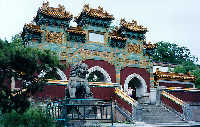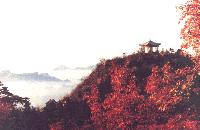Chengde Mountain Resort and Temples
 Chengde Imperial Palace, also known as the Rehe Palace, is in Chengde Mountain Resort.
Chengde Imperial Palace, also known as the Rehe Palace, is in Chengde Mountain Resort.
The palace, which is in the northern part of Chengde City, Hebei Province, was where Qing emperors spent their summer day. Work on the palace began in 1703, the 42nd year of the reign of Qing Emperor Kangxi, and was completed in 1792, the 57th year of the reign of Qing Emperor Qianlong. It covers an area of 5.64 million square meters and includes 110 buildings with a combined floor space of 100,000 square meters. There is a 10-kilometer-long zig-zag palace wall and the resort is the largest intact imperial garden and palace wall and the resort is the largest intact imperial garden and palace in China.
The Mountain Resort has a simple and elegant layout. It was built by the natural mountains and rivers and copying the landscape from southern Jiangsu Province and outside of the Shanhaiguan. The palaces in this large-scale imperial garden were built in a style of quadruple courtyards, with blue bricks and tiles.
There are two parts to the summer resort-the palace itself and a scenic area. The palace was where the emperor lived, handled state affairs and held celebrations or ceremonies. it is made up of the Main Palace, the Crane Temple, Wanhe Songfeng and the East Palace. The scenic area includes a Lake District, a District of Plains and a Mountainous District. The Lake District reflects the landscape of the fish-and-rice villages in southern Jiangsu Province. The Rehe Springs are located in the northeast corner. The western part of the Plain District illustrates a grassland scene from Inner Mongolia While in the eastern part there are ancient trees like the forests of Greater Xingan Mountain. The densely forested mountainous area is on an undulating landscape.
 To the northeast of the Mountain Resort is a monumental temple complex composed of eight outer temples, which were built from 1713 (the 52nd year of the reign of Emperor Kangxi) to 1789 (the 45th year of Emperor Qianlong′s reign). The temples are Furen Temple, Fushang Temple (which has been damaged), Pule Temple, Anyuan Temple, Puning Temple, Xumi Fushou Temple, Putuo Zongcheng Temple and Shuxiang Temple. They were built in Han palace style and drew on the architectural styles of ethnic groups such as Mongolian, Tibetan and Ugyur.
To the northeast of the Mountain Resort is a monumental temple complex composed of eight outer temples, which were built from 1713 (the 52nd year of the reign of Emperor Kangxi) to 1789 (the 45th year of Emperor Qianlong′s reign). The temples are Furen Temple, Fushang Temple (which has been damaged), Pule Temple, Anyuan Temple, Puning Temple, Xumi Fushou Temple, Putuo Zongcheng Temple and Shuxiang Temple. They were built in Han palace style and drew on the architectural styles of ethnic groups such as Mongolian, Tibetan and Ugyur.
The Pule, Puning and Xumi Fushou temples are the main structures of the complex. The Hall of Brightness in the Pule Temple, which has a double-eaved and doom roof is similar to the Hall of Prayer for Bountiful Harvests at the Temple of Heaven in Beijing. In the Hall of the Bodhisattva of the Puning Temple there is a 22.23-meter-high Bodhisattva, which has 1,000 arms and 1,000 eyes. The statue weighs 110 tons and is the highest and largest wood statue in the world. Putuo Zongcheng Temple was modeled on the Potala Palace in Lhasa and is famous as Lesser Potala.
Included in the UNESCO world heritage list in 1994.
Source: http://old.cnta.gov.cn